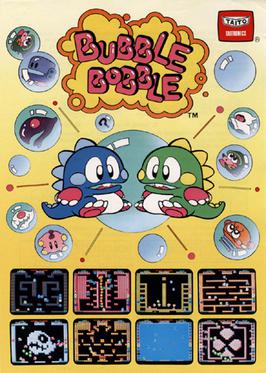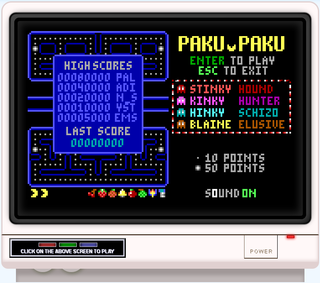Related Research Articles

Bubble Bobble is a 1986 platform game developed and published by Taito for arcades. It was distributed in the United States by Romstar, and in Europe by Electrocoin. Players control Bub and Bob, two dragons that set out to save their girlfriends from a world known as the Cave of Monsters. In each level, Bub and Bob must defeat each enemy present by trapping them in bubbles and popping, who turn into bonus items when they hit the ground. There are 100 levels total, each becoming progressively more difficult.
A turn-based strategy (TBS) game is a strategy game where players take turns when playing. This is distinguished from real-time strategy (RTS), in which all players play simultaneously.

Columns is a match-three puzzle video game released by Sega in 1990. Designed by Jay Geertsen, it was released by Sega for arcades and then ported to several Sega consoles. The game was subsequently ported to home computer platforms, including the Atari ST.

An Internet café, also known as a cybercafé, is a café that provides the use of computers with high bandwidth Internet access on the payment of a fee. Usage is generally charged by the minute or part of hour. An Internet café will generally also offer refreshments or other services such as phone repair. Internet cafés are often hosted within a shop or other establishment. They are located worldwide, and many people use them when traveling to access webmail and instant messaging services to keep in touch with family and friends. Apart from travelers, in many developing countries Internet cafés are the primary form of Internet access for citizens as a shared-access model is more affordable than personal ownership of equipment and/or software. Internet cafés are a natural evolution of the traditional café. As Internet access rose many pubs, bars, and cafés added terminals and eventually Wi-Fi hotspots, eroding the distinction between the Internet café and normal cafés.
A multiplayer video game is a video game in which more than one person can play in the same game environment at the same time, either locally on the same computing system, on different computing systems via a local area network, or via a wide area network, most commonly the Internet. Multiplayer games usually require players to share a single game system or use networking technology to play together over a greater distance; players may compete against one or more human contestants, work cooperatively with a human partner to achieve a common goal, or supervise other players' activity. Due to multiplayer games allowing players to interact with other individuals, they provide an element of social communication absent from single-player games.
A sports video game is a video game that simulates the practice of sports. Most sports have been recreated with video games, including team sports, track and field, extreme sports, and combat sports. Some games emphasize playing the sport, whilst others emphasize strategy and sport management. Some, such as Need for Speed, Arch Rivals and Punch-Out!!, satirize the sport for comic effect. This genre has been popular throughout the history of video games and is competitive, just like real-world sports. A number of game series feature the names and characteristics of real teams and players, and are updated annually to reflect real-world changes. The sports genre is one of the oldest genres in gaming history.

M1 Tank Platoon is a tactical simulator of tank warfare developed and published by MicroProse for the Amiga, Atari ST and MS-DOS in 1989. The game features a mixture of first-person, third-person tank warfare, and tactical simulation gameplay. It was followed by a sequel, M1 Tank Platoon II, released by MicroProse in 1998 for Windows. M1 Tank Platoon was sold to Interplay Entertainment in 2009. M1 Tank Platoon is available on Steam and Epic Games services.

A personal computer game, also known as a computer game or abbreviated PC game, is a video game played on a personal computer (PC). They are defined by the open platform nature of PC systems.

Campaign is a strategy war game developed and published by Empire Interactive. It was released in 1992 for MS-DOS and in 1993 for the Amiga and Atari ST.

Alone in the Dark is a 1992 survival horror video game designed by Frédérick Raynal. Developed and published by Infogrames in 1992 for MS-DOS, the game was eventually ported to MacOS, the PC-98, the FM Towns, the 3DO, the Acorn Archimedes, and iOS. Alone in the Dark is set in 1920s Louisiana and challenges the player to escape a haunted mansion. To advance, the player must solve puzzles while banishing, slaying, or eluding various ghosts and monsters. The player can collect and use weapons, manage a weight-based inventory system, and explore a partially nonlinear map.

Sleeping Gods Lie was a first-person adventure game released on the Amiga, DOS and Atari ST, published by Empire Interactive in 1989.

Centurion: Defender of Rome is a turn-based strategy video game with real-time battle sequences, designed by Kellyn Beck and Bits of Magic and published by Electronic Arts. Originally released for MS-DOS in 1990, the game was later ported to the Amiga and the Sega Genesis in 1991. Centurion shares much of the concept and feel with Beck's earlier game Defender of the Crown (1987).

Empire is a 1977 turn-based wargame with simple rules. The game was conceived by Walter Bright starting in 1971, based on various war films and board games, notably Battle of Britain and Risk. The game was ported to many platforms in the 1970s and 1980s. Several commercial versions were also released, often adding basic graphics to the originally text-based user interface. The basic gameplay is strongly reminiscent of several later games, notably Civilization, which was partly inspired by Empire.
Online games are video games played over a computer network. The evolution of these games parallels the evolution of computers and computer networking, with new technologies improving the essential functionality needed for playing video games on a remote server. Many video games have an online component, allowing players to play against or cooperatively with players across a network around the world.

Elvira: Mistress of the Dark is a horror adventure/role-playing video game developed by Horror Soft and released by Accolade in 1990 for the Amiga, Atari ST, Commodore 64 and MS-DOS computers. It was Horror Soft's second published game after 1989's Personal Nightmare and stars the actress Cassandra Peterson as her character Elvira.

World Class Leader Board is a 1987 golf video game published by Access Software. It is part of the Leader Board series.

Mercenary III is the third and final video game in the Mercenary series. It was written by Paul Woakes for the Atari ST and Amiga and published by Novagen Software in 1992.

Math Rabbit is a 1986 video game spin-off from the Reader Rabbit edutainment series. It was made by The Learning Company for MS-DOS and Apple II series. A Deluxe version was released in 1993 for MS-DOS, Macintosh, and Windows 3.x. In 1997, the game was remade for Windows and Macintosh as Reader Rabbit's Math 1. The final remake for Windows and Macintosh in 1998 is Reader Rabbit's Math Ages 4-6, with a personalized version released in 1999.
Action in the North Atlantic is a 1989 video game published by General Quarters Software.
References
- 1 2 Cadman, Dana L. (November 1991). "The Empire Strikes Fast: jSoft's Second Conflict". Computer Gaming World. 1 (88): 150, 152.
- ↑ Matthews, Robin; Rigby, Paul (1992). The PC Games Bible. Wilmslow, Cheshire: Sigma Press. p. 230. ISBN 1-85058-332-3 . Retrieved 2024-04-13– via Internet Archive.
- ↑ "Second Conflict". Videogame & Computer World (in Italian). No. 7. 1992-04-15. Retrieved 2024-04-13– via Internet Archive.